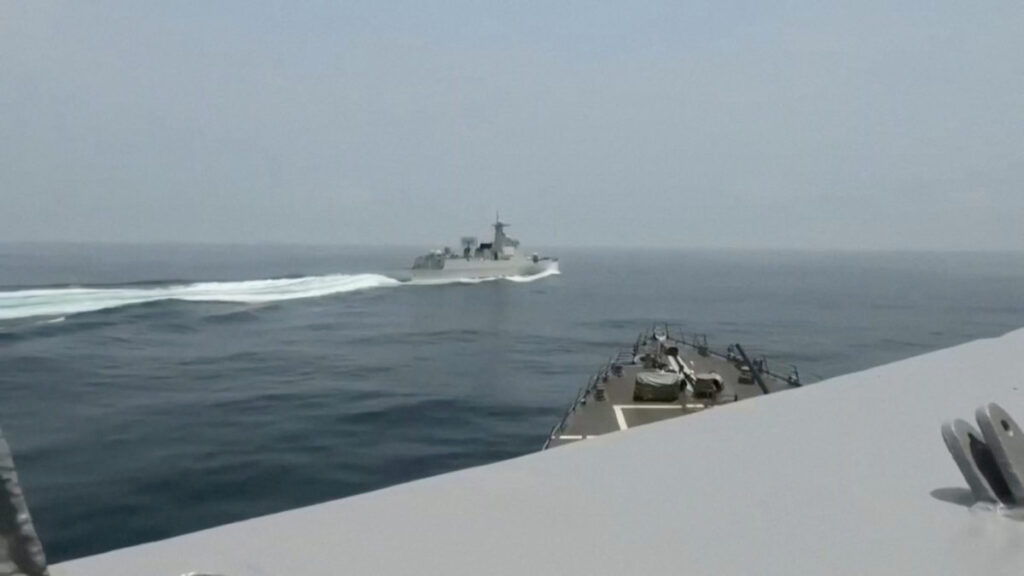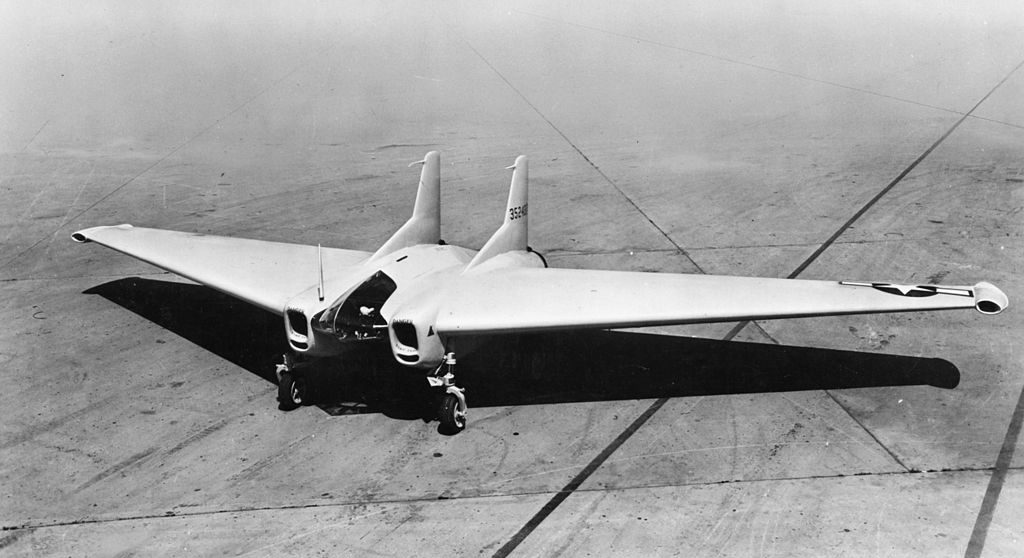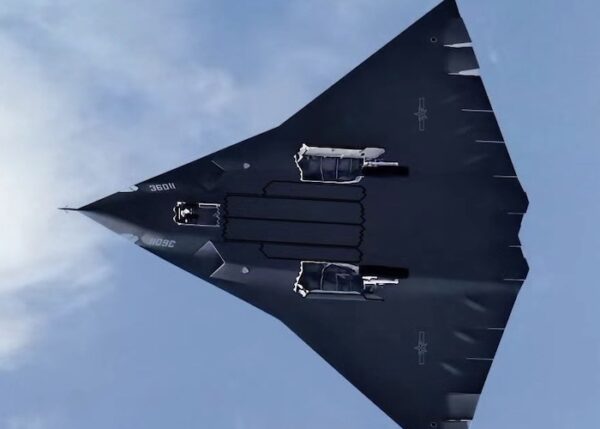Watch: Chinese warship nearly collides with US destroyer near Taiwan
- By Alex Hollings
Share This Article

On Monday, the Pentagon released footage of a close call between Chinese and American warships in the Taiwan Strait that occurred over the weekend. According to American defense officials, a Chinese destroyer performed an “unsafe” maneuver, cutting across the American vessel’s path and forcing the U.S. Navy ship to quickly slow down to avoid a collision.
This marks the third similar incident between Chinese and American forces in recent months.
The USS Chung-Hoon, an Arleigh Burke-class guided-missile destroyer, was reportedly sailing alongside the Canadian frigate HMCS Montreal as the vessels performed a “freedom of navigation” transit through the Taiwan Strait on Saturday.
During the transit, a Chinese destroyer approached from behind at a higher speed, overtook the Chong-Hoon on the port side, and then abruptly changed course, cutting in front of the U.S. Navy vessel at an estimated distance of just 150 yards.
For a ship the size of the Chong-Hoon, at more than 509 feet long and 9,200 tons displacement, it can take a great deal of time and space to stop or turn, making 150 yards an extremely close call.
In effect, this aggressive maneuver could be compared to cutting off another car on the highway and then slamming on your brakes. One could argue that the intent was to not only make the American vessel crash into the Chinese destroyer but to do so in such a way that the Chinese Navy could accuse the U.S. of being the aggressor.
In keeping with that intended narrative, Chinese officials have already gone on record to claim no wrongdoing in the incident.
“China’s military actions are completely justified, lawful, safe and professional,” Chinese Foreign Ministry spokesman Wang Wenbin told reporters. “It is the U.S. that should deeply reflect upon itself and correct the wrongdoings.”
Related: The missile that could save Taiwan from a Chinese invasion
China’s increasingly aggressive intercepts in recent months
This marks the second similar incident between Chinese and American forces in the Pacific in as many weeks, and the third since December. On May 26, a Chinese J-16 fighter jet reportedly cut directly in front of a U.S. Air Force RC-135 Rivet Joint unarmed surveillance aircraft, forcing the larger jet to fly through the fighter’s wake. You can see the fighter’s maneuver, as well as the shaking of the RC-135 from the wake’s turbulence, in footage released by the U.S. Air Force shortly after the incident.
Similarly to the latest incident, Chinese officials were quick to dismiss American claims of unsafe behavior. Instead, Foreign Ministry spokesperson Mao Ning blamed the American aircraft for flying over international waters the Chinese government has claimed ownership of.
Mao then went further, saying that Washington should “earnestly respect China’s sovereignty and security interests and concerns, immediately correct the wrongdoing, show sincerity, and create the necessary atmosphere and conditions for dialogue and communication between the two militaries.”
This too was a repeat of yet another unsafe Chinese intercept of an unarmed American aircraft that happened just about six months earlier. In the previous incident, another U.S. Air Force RC-135 Rivet Joint was intercepted, this time by a Chinese J-11 fighter, which also cut directly in front of it. In this incident, the Chinese fighter reportedly came within just 20 feet of the RC-135.
Chinese officials, however, claimed the Rivet Joint was actually at fault, saying that the larger and slower aircraft altered its flight path and veered toward the Chinese fighter. Of course, the U.S. Air Force also released footage of the incident and the film does not appear to substantiate Chinese claims.
Related: What are FONOPs, and why are they important?
What are FONOPs and why are the U.S. and Canada conducting them near Taiwan?
Freedom of Navigation Operations, or FONOPs, are voyages meant to enforce international law in contested waterways. In simple terms, it means countries sailing their warships through parts of a waterway that should be considered international waters, but is subject to what the international community sees as illegal claims of ownership.
“Chung-Hoon and Montreal’s transit through the Taiwan Strait demonstrates the combined U.S.-Canadian commitment to a free and open Indo-Pacific,” the Indo-Pacific Command said in a statement about Saturday’s incidident. “The U.S. military flies, sails, and operates safely and responsibly anywhere international law allows.”
Despite Taiwan’s longstanding independence, China still claims sovereignty over the entire island and surrounding waterways, prompting other countries, like the United States and Canada, to challenge China’s illegal claims peacefully by traversing nearby waterways by sea and air. These operations are often met by radio warnings from the Chinese military and diplomatic posturing from Beijing’s senior officials.
Related: The US military would likely prevail against a Chinese invasion of Taiwan, but at great cost
This isn’t the first close call between American and Chinese warships either

While FONOPs are widely considered to be more symbolic than tactical, there are indeed a number of risks involved. While conducting FONOP voyages, it’s not at all uncommon for Chinese warships or military aircraft to close with and tail American vessels. Any time there are military assets from two non-allied countries operating in the same area, there’s some degree of risk involved.
In October 2018, that risk resulted in another near-collision between an American destroyer and a Chinese Type 052C Luyang-II destroyer. The United States publicly claimed that China was the aggressor in the near collision, and images taken by the U.S. Navy’s aerial assets of the interaction seemed to substantiate those claims.
Read more from Sandboxx News
- Taiwan Strait Crises: How history is repeating itself in the Pacific
- Which will be the company that will build America’s next stealth fighter?
- Sonic boom shakes DC as F-16s intercept Cessna before crash
- Controlling killer swarms of swarms: Inside DARPA’s AMASS
- The German sniper mask – A visage of terror
Related Posts
Sandboxx News Merch
-

‘AirPower’ Classic Hoodie
$46.00 – $48.00 Select options This product has multiple variants. The options may be chosen on the product page -

‘Sandboxx News’ Trucker Cap
$27.00 Select options This product has multiple variants. The options may be chosen on the product page -

‘Kinetic Diplomacy’ Bumper Sticker (White)
$8.00 Add to cart

Alex Hollings
Alex Hollings is a writer, dad, and Marine veteran.
Related to: Breaking News, Military Affairs

XP-79: The US fighter built to ram enemy bombers

Just how good would an F-22/F-35 hybrid fighter really be?

It doesn’t matter if China’s new J-36 stealth jet is a fighter or a bomber

America almost built its own version of China’s new stealth jet 20 years ago
Sandboxx News
-

‘Sandboxx News’ Trucker Cap
$27.00 Select options This product has multiple variants. The options may be chosen on the product page -

‘AirPower’ Classic Hoodie
$46.00 – $48.00 Select options This product has multiple variants. The options may be chosen on the product page -

‘AirPower’ Golf Rope Hat
$31.00 Select options This product has multiple variants. The options may be chosen on the product page -

‘Sandboxx News’ Dad Hat
$27.00 Select options This product has multiple variants. The options may be chosen on the product page
